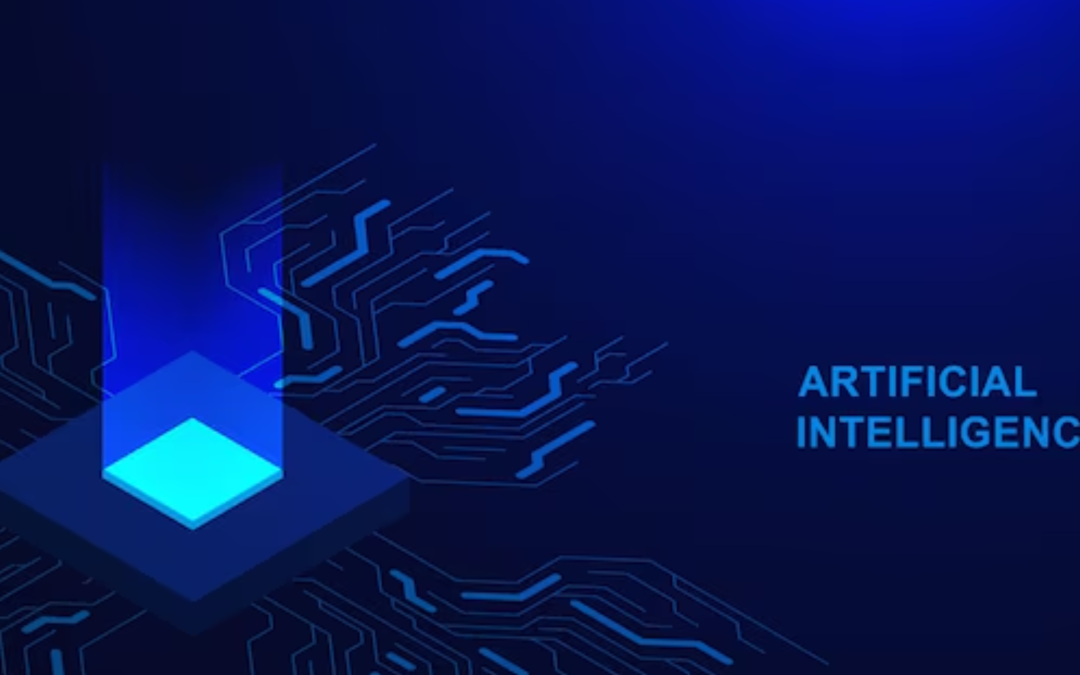
by Shashikanth Heerekar | Jun 28, 2025 | Artificial intelligence
This article explains AI-powered planning clearly, helping you make better, faster business decisions using smart tools and insights.
Introduction:
Have you ever written a list of things to do today? Like: 1) Eating breakfast, 2) Going to school, and 3) Finishing homework. This is called planning.
Now imagine a robot that wants to clean your house. It also requires a list or a plan to complete this task step by step. That’s what planning in artificial intelligence means. It helps machines think ahead, make informed decisions, and complete tasks accurately.
According to Statista, the global AI software market is expected to reach $126 billion by 2025, with a significant portion of this growth attributed to smart systems that can plan, learn, and act independently without human intervention.
In this article, we’ll explore AI planning in a super simple way — even a 4th-grade student can understand it!
Types of AI
Narrow AI (Weak AI)
This type of AI is trained to perform only one specific task. It can’t think or do anything outside that job.
- Examples: Siri, Alexa, Google Maps
- Use in Planning: It can follow fixed plans, such as answering questions or providing directions.
General AI (Strong AI)
This AI can do many things like a human — think, learn, and make decisions.
- Example: A robot that can clean the house, cook food, and answer questions
- Use in Planning: It facilitates the creation of plans for various types of tasks.
Problem Solving in AI
What is Problem Solving?
A machine can find answers to a problem. Example: A robot that wants to see the shortest path to deliver a package.
How is Problem Solving Different from Planning?
- Problem-solving = “What is the solution?”
- Planning AI = “What steps should I take to reach the solution?”
Real-World Example: In chess, problem-solving is deciding how to win. Planning is deciding what moves to make in what order.
Knowledge, Reasoning and Planning in AI
Knowledge in AI
AI must know about:
- The world around it
- Objects and their uses
- Rules of the task (e.g., how to drive)
Without knowledge, planning AI won’t know what to do.
Reasoning in AI
AI uses reasoning to:
- Think logically
- Choose between two actions
- Predict results of actions
Over 65% of AI applications use some form of knowledge-based reasoning.
Learning in AI
What is Learning in AI?
Learning means improving through experience. Just as we learn from our mistakes, AI learns from data.
How Learning Supports AI Planning
- Learns what actions work best
- Gets faster at making good plans
- Adjusts plans over time
Example: A food delivery AI learns the fastest route from data collected over months.
Generative AI
What is Generative AI?
This AI generates new content — including text, images, and music.
- Examples: ChatGPT, DALL-E, Midjourney
Can Generative AI Help with Planning?
Yes! It can:
- Write step-by-step plans
- Suggest ideas for problem-solving
- Improve planning in creative tasks
What is Planning in AI?
Planning in artificial intelligence refers to the process by which machines generate a list of actions to achieve a specific goal.
Key Steps in AI Planning
- Understand the goal
- Know the starting point
- List all possible actions
- Pick the best order to do them
Example: A self-driving car plans its route by:
- Checking where it is
- Finding the destination
- Avoiding traffic and signals
Types of Planning in Artificial Intelligence (AI)
1. Classical Planning
This type is used when everything is known, including actions, results, and the environment.
1.1 Forward State Space Planning (FSSP)
- Starts at the beginning
- Tries every possible step
- Stops when the goal is reached
1.2 Backward State Space Planning (BSSP)
- It starts with the goal
- Works backward
- Tries to match with the starting point
2. Probabilistic Planning
Used when results of actions are not certain. AI plans by guessing which path has the best chance of success.
3. Reactive Planning
Used in changing environments. The AI doesn’t make a full plan in advance. It reacts step by step.
4. Hierarchical Task Network (HTN) Planning
Big tasks are broken into smaller steps.
- Example: “Cook Dinner” → “Make Pasta” → “Boil Water” → “Add Sauce”
Importance of Planning in AI
Why is Planning Important in Artificial Intelligence?
- It makes tasks faster and easier
- It saves energy and time
- Reduces errors
Where is Planning AI Used?
- Robotics
- Healthcare
- Smart homes
- Agriculture
- Transportation
Companies using AI planning tools improved task efficiency by up to 40% (McKinsey, 2023).
Components of Planning System in AI
1. Goals
2. Actions
3. World State
- What is the current situation?
4. Transition Model
- What happens when each action is taken?
5. Plan Validator
- Is the plan working as expected?
Planning Graphs in AI
What is a Planning Graph?
A pictorial model illustrating steps and their potential outcomes. It helps AI choose better paths.
Where is It Used?
- Game AI
- Route optimization
- Logistics planning
Conditional Planning in AI
Conditional planning in AI refers to a machine creating a plan based on potential outcomes. Instead of following a single fixed path, the AI considers various possible scenarios and generates distinct plans for each one. It’s like saying: “If this happens, do that. If it doesn’t, do something else.” This kind of planning helps the machine to be ready for surprises or changes.
For example, imagine a robot wants to enter a room. It first plans: “If the door is locked, I will look for the key.” Then, it also makes a second plan: “If the door is already open, I will walk inside right away.” This makes the robot smarter because it won’t get stuck or confused when the situation changes. Conditional planning enables AI to function more effectively in the real world, where outcomes are not always predictable.
Nonlinear and Partial Order Planning
Nonlinear Planning
In real life, tasks do not always occur one after another in a linear sequence. Sometimes, many things can happen simultaneously. Nonlinear planning enables AI to create plans where steps can occur in different orders or simultaneously. This is helpful when one task doesn’t depend on another, and they can be done in any order.
For example, if a robot is making lunch, it can simultaneously boil water and cut vegetables rather than waiting to finish one task before starting the other. This saves time and makes the AI more efficient. Nonlinear planning is useful for functions where multiple actions can be performed simultaneously without causing problems.
Partial Order Planning
Partial order planning is a type of AI planning where the order of steps is only important for some tasks, not all. That means the machine knows that some steps must occur before others, but the rest can happen at any time. The AI has the freedom to choose the order that works best in the situation.
For example, when setting a dinner table, the robot must first place the plates before serving food. But it can put the fork, spoon, or glass in any order because those tasks don’t depend on each other. Partial order planning enables AI to be flexible and adjust its actions accordingly based on the situation. It gives more control and better results in complex tasks. Challenges in AI Planning
AI is very intelligent, but it also faces significant challenges when making plans. Let’s examine the most common challenges in planning for AI.
Time Limits – AI Must Decide on a Fast
Some tasks require very quick decisions, such as stopping a robot from bumping into an object or reacting to a sudden change in traffic for self-driving cars.
However, even the most advanced computers require time to process information. If they don’t make decisions quickly enough, it can lead to accidents or mistakes.
Example: A delivery robot must quickly choose the best path in a busy street. If it takes too long, it might get stuck or cause delays.
Why it’s hard: AI must check many options and pick the best one in just a few seconds.
Big Data – Too Much Information Can Be Confusing
AI systems utilize a substantial amount of data to make informed decisions. However, sometimes, there’s too much data, which can slow down the system or make it harder for the AI to determine what is important.
For example, suppose an AI is tasked with planning a trip and receives weather reports, traffic updates, road maps, and user preferences simultaneously. In that case, it may struggle to determine the best course of action.
Why it’s hard: Sorting useful data from extra data is like finding a needle in a haystack. This is a huge challenge in planning AI.
Uncertain Results – The Same Action Might Give Different Outcomes
In real life, things don’t always go as planned. Even if an AI plan is perfect, the result may differ each time.
Let’s say an AI instructs a robot to pick up a glass. Sometimes, it picks it up just right. At other times, the glass might slip or break, depending on small changes such as hand position or object weight.
Why it’s hard: AI has to guess the future with limited information. This makes planning in AI difficult because there’s always a chance things will go wrong.
Future of AI Planning
Trends
- AI + IoT
- Real-time dynamic planning
- Natural language planning
Opportunities
- AI helping farmers
- AI planning school schedules
- AI helping hospitals
Conclusion
Planning in artificial intelligence is one of the most crucial aspects that enables machines to act intelligently. Just like humans make a plan before doing a big task, machines also need to think and plan their steps. This planning enables AI to complete tasks smoothly, quickly, and with fewer errors. Whether it’s a robot vacuum cleaning your house, a GPS finding the fastest route, or a smart assistant answering your questions, they all rely on planning to do their job effectively. AI planning is not just about completing tasks but doing so in a more efficient way by saving time and effort.
Today, we are already utilizing AI planning in various various areas, such as transportation, healthcare, home automation, and business. But this is just the beginning. As technology advances, machines will become even more adept at planning their tasks. In the future, we may see robots planning large-scale projects, assisting in emergencies, or even solving global problems using intelligent solutions. With strong and smart AI planning, the world can become safer, faster, and more efficient. Therefore, planning in AI is not only helpful today but will become even more powerful and effective in the years to come.
FAQ’s
1. What is AI planning in simple words?
AI planning involves teaching a machine to think ahead and choose the optimal steps to complete a task. It’s like giving the machine a small brain that can decide what to do first, next, and last. Just as we plan our day or make a to-do list, the machine also creates a plan to complete its job correctly. This helps the AI work more effectively and avoid making errors.
2. Why is planning important in AI?
Planning is crucial in AI because it enables the machine to understand what to do and how to do it most effectively. Without a plan, the AI might make incorrect moves or waste time repeating the same actions over and over. A good plan provides the AI with a clear path to follow and enables it to make informed decisions. It also allows you to complete the task more quickly and accurately.
3. What are examples of AI planning?
A good example of AI planning is a robot vacuum that plans the most efficient path to clean every corner of your room. Another example is a GPS app that plans the shortest or fastest route for you to reach your destination. A self-driving car also uses AI planning to avoid traffic, follow rules, and get safely. Even voice assistants like Alexa or Siri plan their replies based on your question.
4. What is classical planning in AI?
Classical planning in AI refers to the machine having complete knowledge of the problem before it begins working. It knows the steps, the rules, and the result it wants to reach. The AI follows each step in the sequence, just as one would follow a cooking recipe. There are no surprises or changes along the way, so the AI finishes the job exactly as planned.
5. What is hierarchical planning?
Hierarchical planning involves breaking down a large task into smaller, more manageable tasks for the AI. Instead of doing everything at once, the machine does one small part at a time. For example, cleaning a house can be divided into cleaning one room at a time and then moving on to the next. This type of planning enables the AI to manage work more effectively and complete large tasks step by step without confusion.
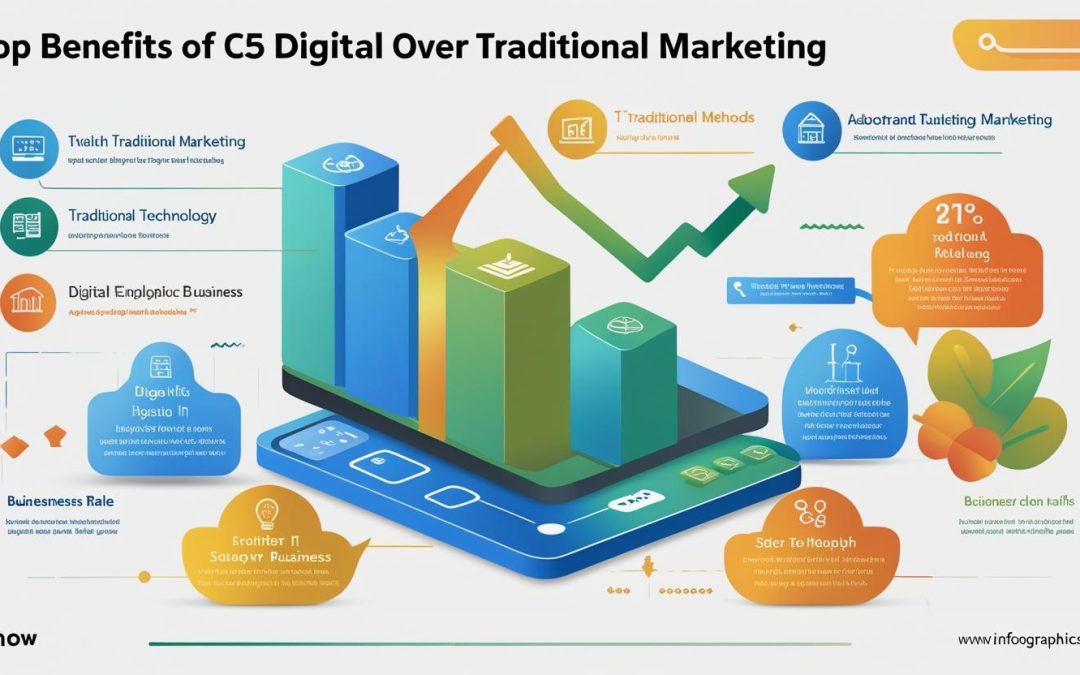
by Shashikanth Heerekar | Jun 26, 2025 | All Things about Marketing
Digital marketing offers better targeting, lower cost & real-time results. Please find out how it outperforms traditional ads for modern businesses.
Introduction
Marketing has undergone significant changes—from traditional to digital. Now, we use phones and computers. Digital and non-digital marketing help sell stuff. Some of the advantages of online advertising are fast reach and easy sharing. The advantages of website marketing and web marketing include 24/7 selling. However, there are also limitations to Internet marketing. Still, the benefits of digital multimedia are super cool.
Defining Digital Marketing: Key Characteristics and Components
1. What is Digital Marketing?
Digital marketing is the use of phones, computers, and the Internet to advertise goods and services to others. It’s fun because you can see cool videos or ads online. There are digital marketing pros, such as reaching people quickly. However, digital marketing has its drawbacks, such as requiring a stable internet connection and sometimes becoming too complex. That’s why we need to consider the advantages and disadvantages of digital marketing before implementing it.
2. Traditional Marketing vs. Digital Marketing
In the past, people sold things using newspapers, posters, and radio advertisements. These are called traditional marketing advantages. One big advantage of conventional marketing is that you don’t need the Internet! But it’s slow and hard to change, which are disadvantages of traditional marketing. When discussing the pros and cons of marketing, it is essential to consider both types. Marketing pros and cons help us pick the best way to share our ideas.
3. Benefits and Cons of Traditional Marketing
Traditional marketing benefits are particularly suitable for older individuals or those without internet access. It feels more real and trusted, which is another advantage. However, printing ads can be costly and time-consuming, which are disadvantages of traditional marketing. We must always consider the advantages and disadvantages of digital advertising to make informed choices.
4. Which One is Better?
It depends! Some prefer the new approach, which utilizes phones and computers and appreciates the digital marketing advantages. Others still prefer the old way due to its traditional marketing advantages. But no matter what, both have good and bad sides. So, when considering marketing pros and cons, remember that every idea has both bright and not-so-bright aspects.
Enhanced Reach and Targeting: The Advantages of Digital Marketing
Digital marketing is like magic! With a single click, you can reach everyone on the planet. That’s one of the big digital marketing pros. Unlike traditional marketing methods, which often involve using posters or flyers, digital approaches are faster and more engaging. With the Internet, you can show ads on YouTube, Google, or Instagram. These are all online marketing advantages!
But let’s not forget the drawbacks of digital marketing. Sometimes, your ad might reach people who don’t care, or you spend too much money. That’s why we’re discussing the advantages and disadvantages of digital marketing, so you can understand the benefits and drawbacks of digital and avoid common mistakes.
Some people still love traditional digital marketing because it feels safer and familiar. When we examine the pros and cons of advertising, we see that both approaches have strengths and weaknesses. While traditional ads stay in newspapers or billboards, digital ones pop up on our phones. This is why there’s always a battle between digital and traditional marketing.
One significant reason people love digital marketing is that it allows you to target your ads to the right audience. This is called targeting. When discussing the pros and cons of marketing, targeting is a significant advantage. Still, the disadvantages of digital marketing, such as online scams or excessive ads, are a concern.
Even with digital marketing’s disadvantages, we can’t ignore its coolness. You can see who clicked your ad and even who made a purchase. That’s a major win in social media marketing, both pros and cons. Just like the pros and cons of social media marketing, it’s all about being smart and careful with your choices.
Cost-Effectiveness: Evaluating ROI in Digital vs. Traditional Marketing
1. Cost of Traditional Marketing
When discussing traditional marketing, we consider newspapers, billboards, TV, and radio ads. These are referred to as conventional marketing methods and can be quite costly. Buying space in the paper or time on TV is super pricey. That’s one reason some people are moving away from traditional media marketing. When asked what traditional marketing is, it refers to selling products or services using conventional methods, such as print advertisements in magazines or posters. While local marketing professionals appreciate these methods because they work well in small towns, it remains challenging to measure results. This makes traditional marketing versus digital marketing tricky to choose because you might spend a lot but not know if it is effective.
2. Cheaper Options in Digital Marketing
Now, let’s discuss the Internet—digital and traditional marketing are quite different in terms of financial considerations. Digital ads are more cost-effective, and you can reach a large audience quickly. That’s one of the biggest pros of the web market. Posting on Facebook or running a Google ad costs less than TV ads. So, if we compare digital advertising vs traditional advertising, the digital one saves more money. Additionally, we can see who clicked and who made a purchase to determine if it’s effective. That’s a big win in traditional and digital marketing.
3. Which One Gives More Value?
Suppose we consider value or ROI (return on investment) and digital wins. That’s why many marketers read Marketing Pros magazine to stay updated. Still, there are online marketing disadvantages, like scams or ads being ignored. Some also mention the disadvantages of digital marketing, such as the need for an internet connection and access to smart tools. Combining traditional and digital marketing approaches is a smart strategy for achieving the best results. In digital versus conventional marketing, we must choose the approach that best fits our goals and budget.
Measurable Results: Analyzing Performance Metrics in Digital Campaigns
With digital marketing, you can see what’s working and what’s not! That’s super cool because when we compare digital marketing to traditional marketing, digital marketing helps with things like clicks, likes, and sales. It’s challenging to determine if someone has seen your ads in conventional marketing channels, such as newspapers or radio. This is a significant reason why people transition from traditional to digital marketing. We can track numbers and know what to do next.
The advantages of marketing online include knowing exactly how many people clicked your ad. This helps fix things quickly if something isn’t working. However, the disadvantages of Internet marketing can be tricky, too—sometimes ads show up to the wrong people, or the Internet stops working. Internet marketing has some drawbacks, and we must be careful about them.
Still, digital media yields clearer results than traditional advertising, such as billboards or TV. That’s why traditional vs. digital marketing always starts with this big difference—numbers! In conventional marketing methods, like the type used in old times, you can’t see who looked at your poster. This makes it harder to improve your campaign.
Additionally, in the context of Internet marketing versus traditional marketing, digital is generally faster. If an ad isn’t doing well, you can change it immediately. That’s not easy in conventional online marketing, like ads in a newspaper. The online marketing pros include testing different ads to see which works best. On the other hand, the pros and cons of advertising on radio show that while it reaches local people, it’s not always easy to track who’s listening. Social media advertising has its pros and cons—some love it, while others find it overwhelming.
Although traditional marketing methods are still effective, digital marketing enables you to track everything, making a significant difference.
Flexibility and Adaptability: Responding to Market Changes with Digital Marketing
1. Easy to Make Changes Quickly
With digital marketing, we can quickly fix any issues that aren’t working. Unlike traditional marketing, where you can’t change a newspaper ad once it’s printed, digital ads allow us to change pictures, words, or even the entire ad at any time. This makes digital advertising advantages super cool. In the digital marketing vs. traditional marketing debate, digital marketing emerges as a clear winner.
2. Testing Different Ideas
We can try many ads and see which one works best. That’s called A/B testing. It’s part of the web marketing advantage. You only get one shot in traditional marketing strategies, like billboards or flyers. However, digital technology allows us to test new ideas every day. That’s something traditional marketing strategy can’t do fast.
3. Reaching People Anytime
Digital marketing is on 24/7! That means you can show ads in the morning, at night, or anytime someone is online. This is a significant difference between traditional and non-traditional advertising, as traditional ads are only shown during set times. So, in digital vs traditional marketing, digital is more awake!
4. Updating for Trends Fast
When something new happens, such as a holiday or a trend, digital marketing can respond quickly. That’s a cool marketing strategy advantage. You can make posts, videos, or ads in minutes. However, in traditional marketing approaches, such as magazines, you wait weeks for printing. That’s why people love social media marketing pros over slow ads.
5. Matching Customer Behavior
Digital ads learn what people like and can adapt based on their online behaviour. This helps in content marketing, as opposed to traditional marketing, where content is tailored to your preferences. However, conventional marketing methods remain the same once they’re deployed.
6. Better Use of Budget
If one ad is performing well, we can allocate more funds to it. If another is bad, we stop it. That’s super smart and saves money. This is a significant advantage in terms of the pros and cons of advertising. Unlike traditional marketing versus online marketing, where money is already spent, digital helps us make better choices
Conclusion
The benefits of digital marketing help businesses grow fast! Although traditional marketing advantages are beneficial, digital marketing in B2B businesses is more effective today. The distinction between conventional and digital marketing demonstrates that both digital and traditional marketing are important. However, the future remains bright, with digital marketing surpassing traditional marketing in its digital transformation.
Top 5 FAQs
1. What distinguishes digital technology from traditional marketing?
The placement of advertisements is where digital and conventional marketing diverge most. Traditional marketing uses newspapers, TV, or radio. Digital marketing uses the Internet, like websites and social media. Digital is faster, cheaper, and easier to track. Traditional methods still work, but they are slower and more difficult to measure.
2. Why is digital marketing better for B2B businesses?
Digital marketing in B2B is effective because it enables companies to connect with other businesses quickly. It’s easier to explain big services with tools like email, LinkedIn, and websites. Compared to traditional methods, B2B web marketing is more affordable and has a wider audience. It’s smart and helps build long-term business friendships.
3. Are there still any benefits of traditional marketing?
Yes! Traditional marketing benefits still exist. It’s trusted, especially in local markets. Things like flyers, radio, and billboards can feel more personal. Sometimes, people trust printed ads more than online ones. While digital marketing is popular, the advantages of traditional marketing still benefit businesses in certain areas or industries.
4. What are the top benefits of online and digital marketing?
The top benefits of digital marketing include fast reach, low cost, and easy tracking. You can change ads quickly and target the right people. Online marketing also means 24/7 access and global reach. It’s ideal for both small and large businesses that want to grow quickly.
5. How does digital marketing support the move from traditional to digital?
Traditional digital marketing refers to using the Internet as a medium as opposed to conventional media such as newspapers or television. The digital marketing and traditional marketing mix help during the change. Start with a website or social media. This makes the shift easy and allows you to enjoy the benefits of web marketing, such as increased reach and lower costs.
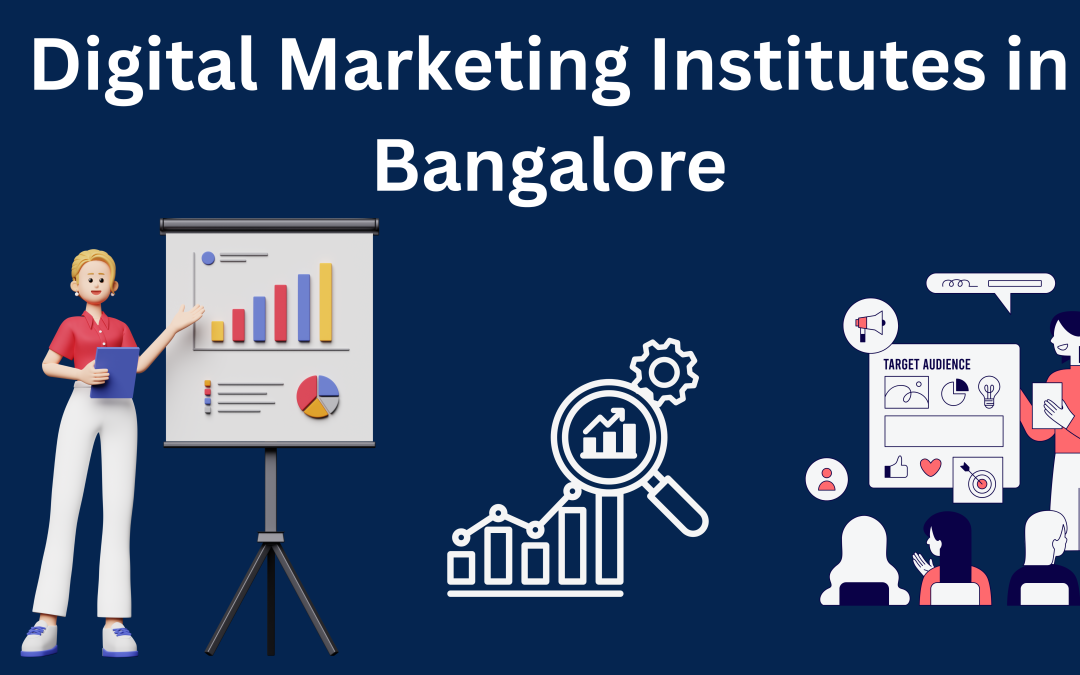
by Shashikanth Heerekar | Jun 25, 2025 | Digital Marketing
Learn about Oxygen and Kandradigital, Bangalore Digital Marketing, eMarket Education, Web Marketing Academy, and Bangalore’s , AADME Consulting & Coaching Pvt Ltd, Inventateq, BDM, iDigital Academy, EMarket Education, gmcsco, top ten digital marketing institutes. Learn about their expert training programs in SEO, social media, UI/UX, and content marketing to boost your digital skills and career.
Introduction
Bangalore, India’s tech capital, is also emerging as a digital marketing education and skill development hub. Whether you’re a student aiming to break into the digital industry or a professional seeking to upgrade your skills, the city offers top-tier digital marketing institutes.
These training centers provide hands-on experience in SEO, social media marketing, PPC, content marketing, and more, helping individuals and businesses stay ahead in the evolving digital landscape.
Here are the top 10 digital marketing institutes in Bangalore, with a special mention of Oxygen, a seasoned industry leader from Hyderabad making a strong impact across India.
Oxygen
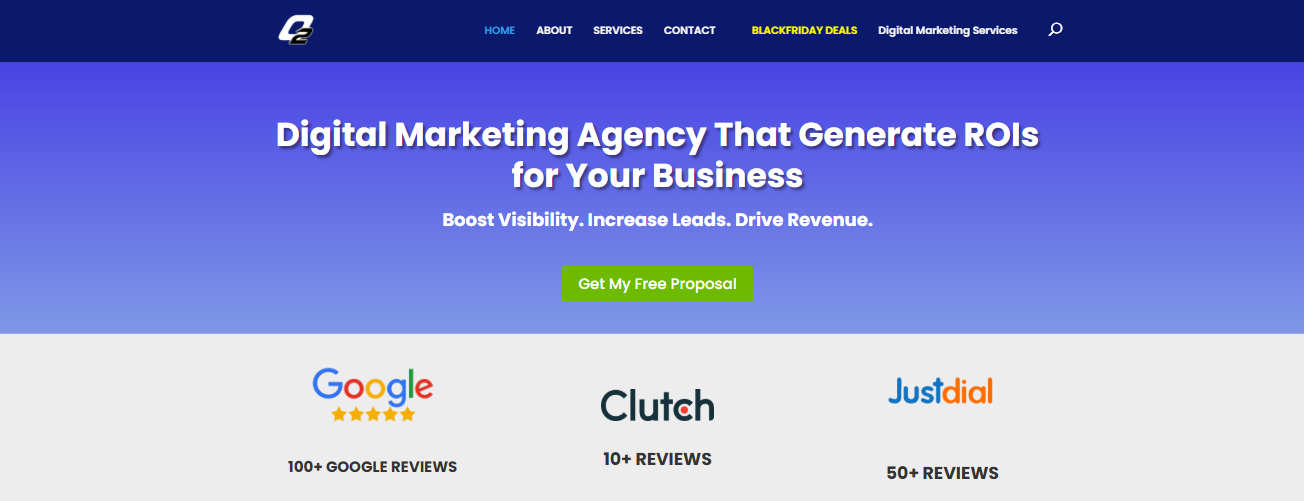
Oxygenites
Though headquartered in Hyderabad, Oxygen has earned a nationwide reputation for excellence in digital marketing education and services. With over 13 years of industry experience, Oxygen offers a robust curriculum for beginners, entrepreneurs, and working professionals.
Oxygen’s practical, real-world training sets it apart. It covers SEO, social media marketing, content creation, paid advertising, and digital analytics. The company’s trainers are industry experts who combine academic knowledge with real-world project exposure.
Contact Details
Kandradigital
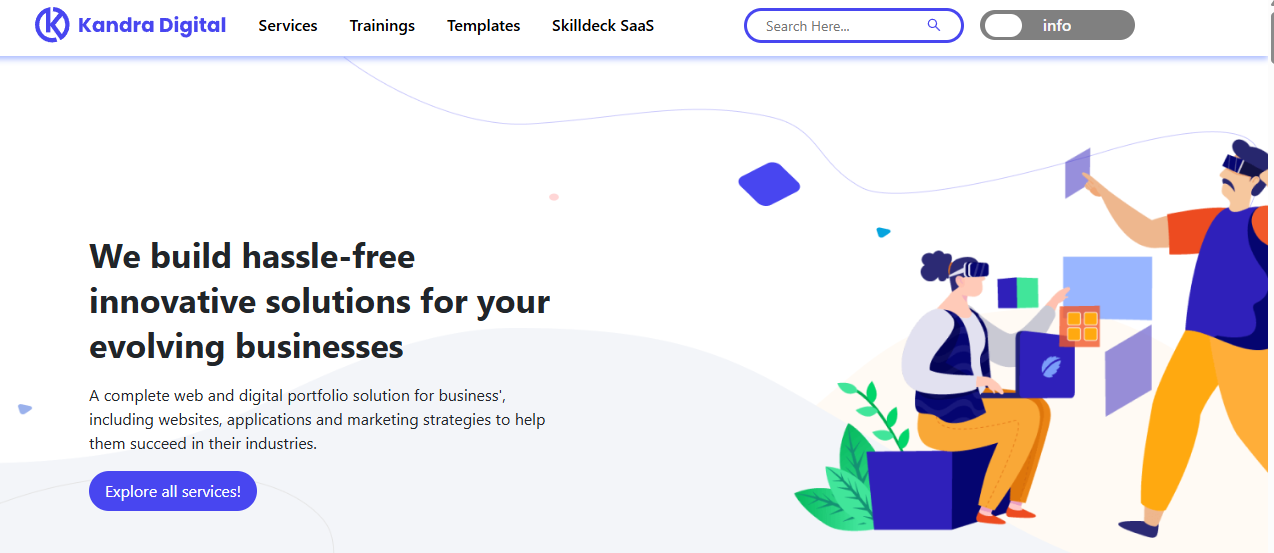
KandraDigital
KandraDigital is a Bangalore-based digital marketing training institute known for delivering premium, agency-style learning experiences tailored for graduates, working professionals, entrepreneurs, and corporate teams. What sets KandraDigital apart is its focus on hands-on, real-time, project-based learning, backed by live case studies and personalized guidance—preparing learners to meet real-world industry challenges from day one.
Recognized as one of the best digital marketing institutes in Bangalore, KandraDigital offers job-oriented training programs that include one-on-one mentorship, corporate upskilling modules, and interactive classroom sessions. The institute delivers a comprehensive suite of digital marketing courses, including
SEO (Search Engine Optimization)
Performance Marketing (Google Ads, Meta Ads, and more)
Social Media Marketing
Content Marketing
HubSpot Marketing Automation
E-commerce Marketing
Analytics & Reporting
Influencer Marketing
Email Marketing and CRM Tools
Affiliate & Programmatic Advertising
At the core of KandraDigital’s reputation is Manjunath Chowdary, a seasoned digital marketing expert with over 15 years of experience working with India’s top-tier brands such as Redbus, BigBasket, Mobikwik, Dailyhunt, UpGrad, and several global companies. Prominent for his lucidity, profound knowledge of the subject, and ability to teach in multiple languages (English, Telugu, Kannada, and Hindi), Manjunath guarantees that all students, regardless of their background, acquire a solid practical foundation and abilities that are ready for the workplace.
What makes KandraDigital unique is its dual role as both a functioning digital agency and a training hub, enabling learners to work on real-time projects under expert supervision. In addition to training, the company provides services in web development, mobile app development, and 360° digital marketing, offering students unmatched exposure to live tools, strategies, and campaigns.
Established in 2018, KandraDigital has built a strong global presence, with learners enrolling from across India and internationally through its live virtual training programs.
Whether you’re looking to launch a career in digital marketing, upskill your current role, or train your team with real-world strategies, KandraDigital offers the expertise, infrastructure, and credibility to help you succeed.
Contact Details
AADME Consulting & Coaching Pvt Ltd

Aadme
AADME is a leading digital marketing institute known for its innovative and practical approach to digital education Their wide range of programs caters to different learning needs, including a Lifetime Mentorship Program, an intensive 4.5-month course, and a specialized Digital Marketing Course with AI—providing learners with advanced tools and insights for future-ready skills.
For those seeking faster learning options, they offer a Fast Track Program as well as an Offline Digital Marketing Course in Bangalore for hands-on classroom training 8 Weeks Business Fast Track Consulting Program for IT Founders & professionals, agencies, freelancers & business owners and they have trained 51,743+ students. AADME is highly regarded for its expert mentorship, career-focused curriculum, and strong commitment to empowering students with both foundational and advanced digital marketing skills, making it a popular choice for aspiring digital marketers in Bangalore.
Courses offered
LifeTime Mentorship Program
4.5-Month Program
Digital Marketing Course With AI
Fast Track Program
Offline Digital Marketing Course Bangalore
AI-enabled digital marketing course with paid internship
digital marketing course for freelancing
Digital Marketing Agency Building With AI
Contact Details
Web Marketing Academy
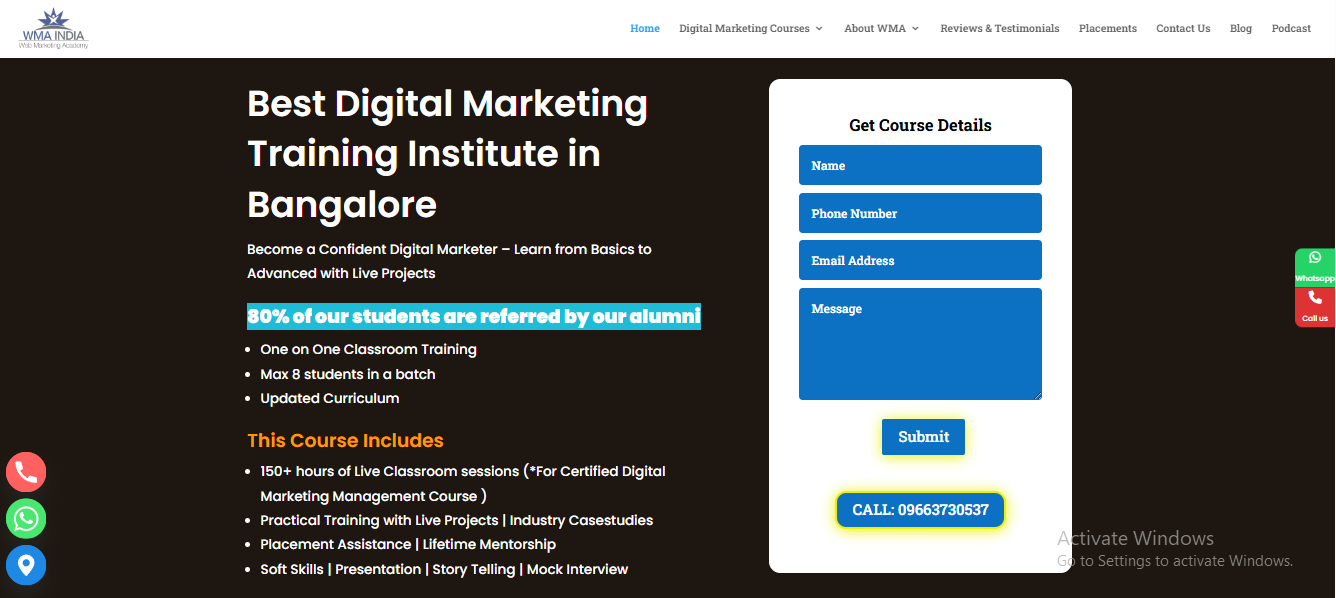
Web marketing
Web Marketing Academy (WMA) is a leading digital marketing institute in Indiranagar, Bangalore. Known for its hands-on, classroom-based training, WMA offers a comprehensive 3–4 month digital marketing certificate course. Designed for students, professionals, entrepreneurs, and freelancers, the program focuses on practical application and in-depth learning.
The course curriculum covers over 40+ modules, including website creation with WordPress, SEO (on-page, off-page, local), Google Ads (Search, Display, Shopping), social media marketing (Facebook, Instagram, LinkedIn), content creation with AI tools, email marketing, blogging, YouTube video marketing, affiliate marketing, remarketing, Google Analytics, and influencer marketing. Students also receive training on resume writing, portfolio building, and mock interviews to help with job placements or starting a freelance career.
What Makes WMA Unique:
- Small class sizes for personalized attention (max. 8-10 Students per batch)
- Real-world projects using industry tools and platforms (Live projects for each module to get a Hands-on learning experience)
- Up-to-date curriculum taught by experienced professionals (updated 2025)
- Lifetime mentorship and placement support (Job-oriented certification course)
- Proven track record with students placed in startups and top companies like Google, Facebook, TCS, Cognizant, Yahoo, Decathlon, etc.
Web Marketing Academy combines deep learning with real-world exposure, ensuring students gain the knowledge and confidence to succeed in the digital marketing industry.
Contact Details
Inventateq
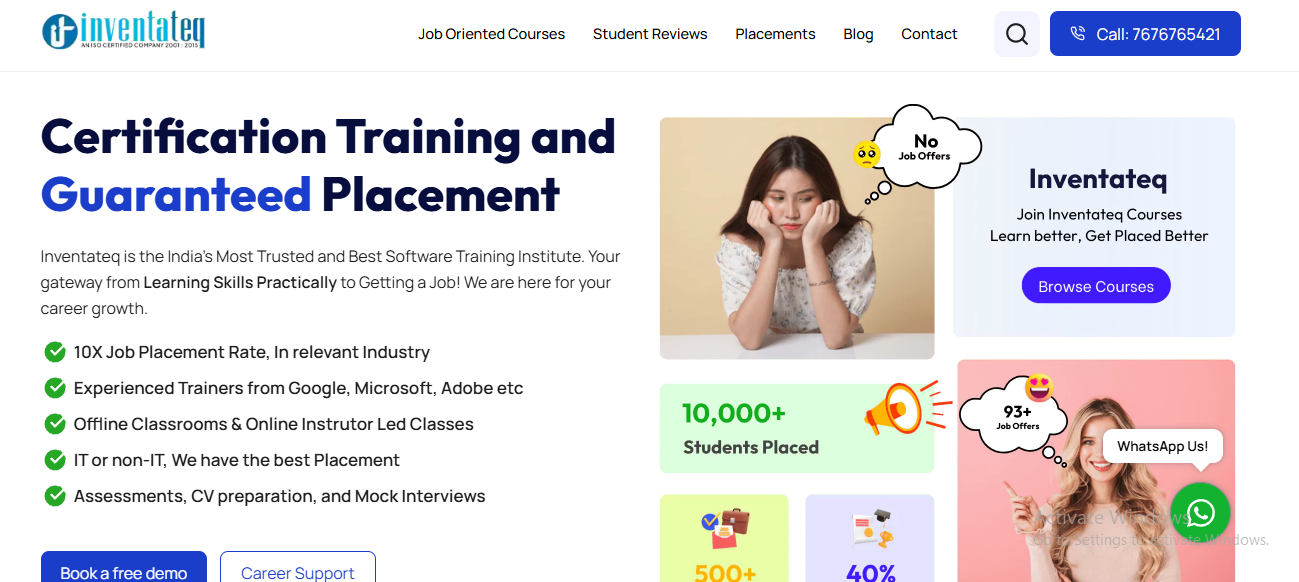
INVENTAEQ
Inventateq is a well-established digital marketing training institute in Bangalore, recognized for offering comprehensive, career-oriented courses in digital marketing and web solutions.
Their course offerings include SEO, PPC (pay-per-click), link building, social media marketing, and online reputation management, equipping students with a broad skill set in demand in today’s job market.
Inventateq also provides access to offshore hiring resources, such as SEO specialists and social media marketers, reflecting their strong industry network and practical orientation.
Additionally, learners benefit from training in web design, logo creation, and web development, making it an excellent choice for those who want both marketing and design expertise. With an emphasis on live projects, placement support, and real-world application, Inventateq continues to be a preferred digital marketing institute in Bangalore.
courses offered
Seo
Pay-per-click (PPC)
Link Building
Social Media Marketing
Online Reputation Management
Web Design
Web Development
Logo Design
Contact Details
BDM
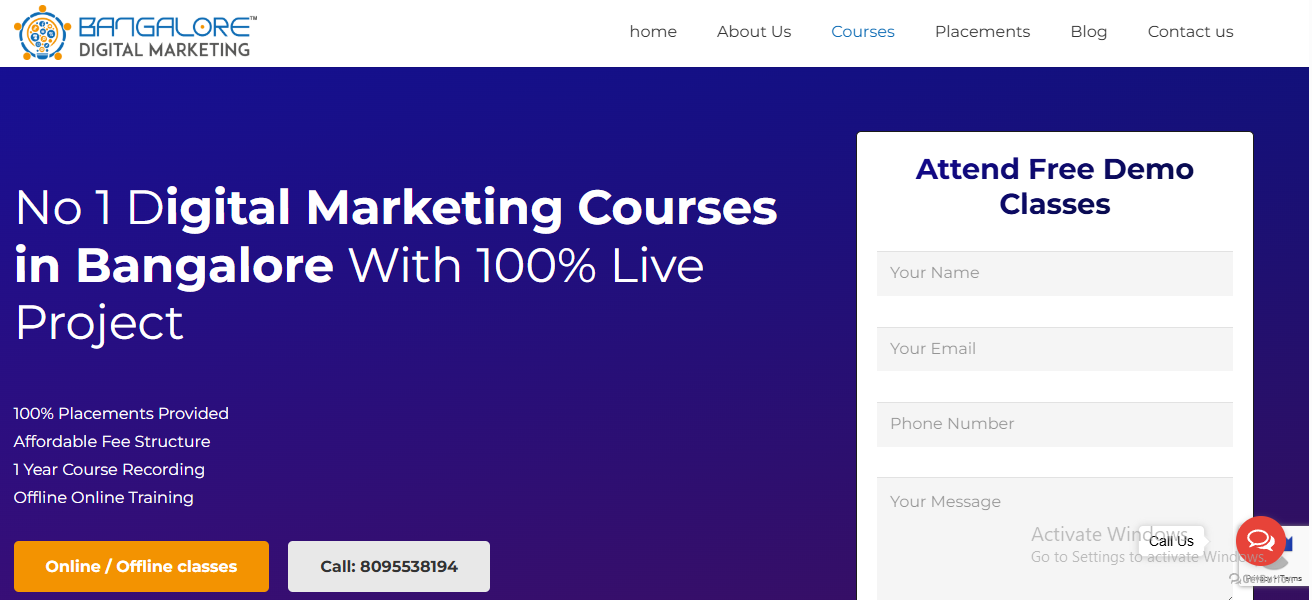
BDM
BDM is a prominent institute known for delivering comprehensive, hands-on training in key areas of the digital marketing ecosystem.
The institute offers specialized courses in digital marketing, UI/UX design, SEO, PPC training, and graphic design, catering to beginners and professionals looking to strengthen their skills.
Students benefit from practical learning modules, live project exposure, and expert mentorship that bridge the gap between academic knowledge and industry requirements.
Additionally, their social media marketing and video editing courses make them a well-rounded choice for aspiring content creators and performance marketers. With a strong emphasis on creative and technical skills, Bangalore Digital Marketing is considered one of the top digital marketing training institutes in Bangalore.
courses offered
Digital Marketing
UI/UX
SEO
graphic design
PPC training
Social media marketing
video editing
Contact Details
iDigital Academy
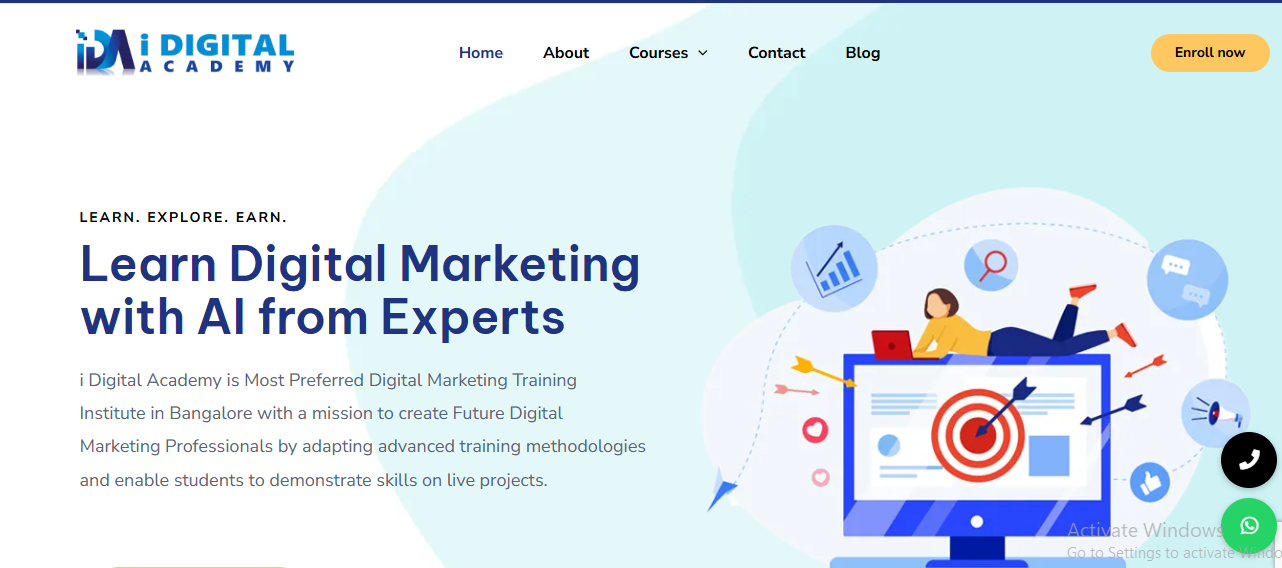
IDIGITAL ACADEMY
iDigital Academy is a Trusted training center in Bangalore that provides career-focused courses in graphic design and digital marketing. Renowned for its hands-on approach and knowledgeable instructors, the academy gives students exposure to real-world projects and imparts in-demand skills that are in line with current business trends.
Their Advanced digital marketing course with AI is designed to cover SEO, social media marketing, Google Ads, and content strategies, ensuring students gain the confidence and knowledge to handle real business challenges with their Agency Based Training and Internship Oppurtunities.
With flexible schedules, interactive classes, and dedicated placement support, iDigital Academy has become a go-to choice for aspiring digital professionals looking to build a strong foundation and advance their careers. They offer Classroom, Online and Corporate Training.
courses offered
Digital marketing course
Graphic Design course
Contact Details
GMCSCO Media Group
GMCSCO is a leading digital marketing company in Bangalore, widely recognized for delivering specialized training and result-driven services in the digital marketing space. Their digital marketing courses and services are thoughtfully designed to cover essential areas such as search engine optimization (SEO), WhatsApp marketing, paid advertisements, owned media optimization, and retention marketing—ensuring that learners gain hands-on expertise in all key aspects of digital marketing.
In addition to their digital marketing focus, they provide services in web development, mobile app development, and software development, helping students and professionals grasp both marketing and technical skills for comprehensive career growth. Their programs are practical, career-oriented, and ideal for learners looking to master digital marketing in today’s data-driven and competitive landscape.
courses or services offered
Web Development
Mobile App Development
Software Development
Search Engine Optimization
Paid Advertisements
Owned Media Optimization
Retention Marketing
Data Analytics & Insights
Domain, Hosting, and SSL
IT/Server Support
Contact Details
EMarket Education
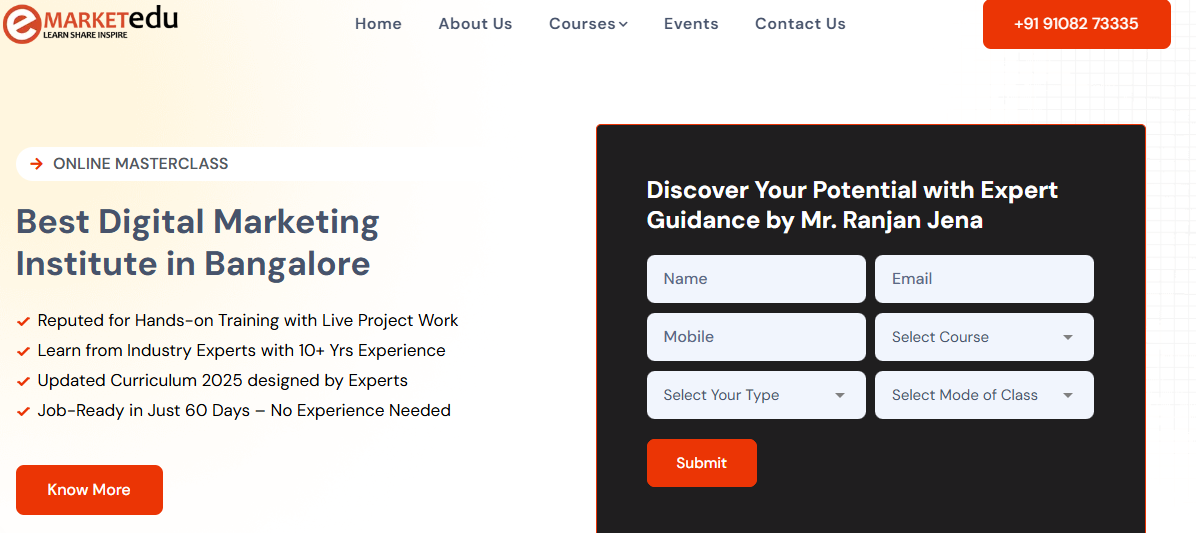
Emarketing Education
eMarket Education is one of Bangalore’s most reputed institutes. It offers specialized training in digital marketing with a strong focus on practical knowledge and career-oriented skills.
With a curriculum designed by industry professionals, the institute equips students with the essential tools and techniques to succeed in today’s competitive digital world.
Their digital marketing course covers SEO, Google Ads, social media marketing, analytics, and more, ensuring students gain real-time project experience and industry certification.
Known for its personalized mentoring, small batch sizes, and placement support, eMarket Education is a top choice for those seeking quality digital marketing training with real-world applications in Bangalore.
courses offered
Digital marketing course
PPC Google ads course
Social media marketing
SEO
Soft skills and interviews
Adobe analytics training
power BI training
Python Training
GTM training
Contact Details
- Phone: 91082 73335
- Email: [email protected]
- Website: https://www.emarketeducation.in/
Conclusion
Choosing the right digital marketing institute in Bangalore can be a transformative step in building a successful career in the digital space. Whether you’re a beginner looking to enter the field or a working professional aiming to upgrade your skills, Bangalore offers a variety of training programs that focus on practical knowledge, real-time projects, and industry-relevant tools.
These institutes provide comprehensive training in SEO, PPC, content marketing, social media marketing, UI/UX design, and more. With structured curriculums, expert trainers, and placement support, learners are equipped to meet the growing demand for skilled digital marketers across industries. Enrolling in a reliable and forward-thinking digital marketing course ensures you stay competitive in today’s fast-evolving digital economy.
FAQS
1. In digital marketing classes, what subjects are frequently covered?
A. A standard digital marketing course includes SEO, PPC, Google Ads, content marketing, social media marketing, email marketing, analytics, and sometimes UI/UX and video editing.
2. Can I learn digital marketing online from Bangalore institutes?
A. Many institutes offer flexible online training modules that include live classes, recorded sessions, and one-on-one mentoring, making it easy for remote learners to gain valuable skills.
3. What job role is available after completing a digital marketing course?
A. Graduates can pursue roles such as SEO specialist, social media manager, content marketer, PPC analyst, digital strategist, UI/UX associate, or marketing automation executive.
4. How long will it take to complete a digital marketing course?
A. The duration can range from 1 to 6 months depending on the depth of the course, delivery mode, and whether it includes internships or capstone projects.
5. In a course on digital marketing, what kinds of tools are usually taught?
A. Courses often include hands-on training in tools like Google Analytics, Google Ads, SEMrush, Ahrefs, Canva, Meta Business Suite, Mailchimp, and WordPress.
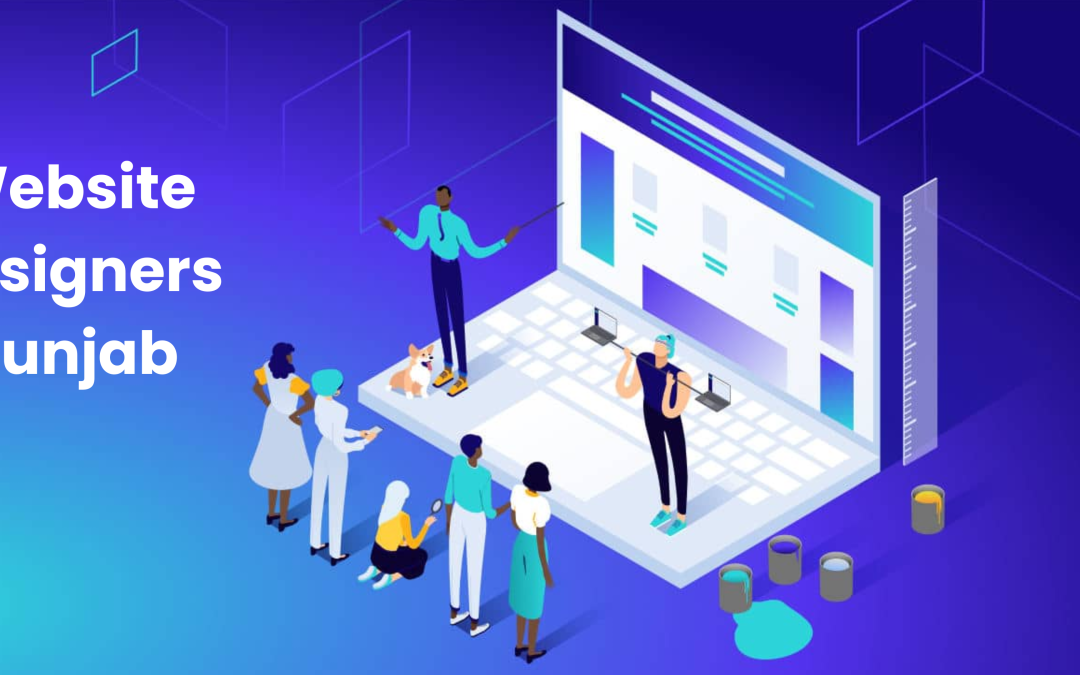
by Shashikanth Heerekar | Jun 24, 2025 | All Things about Marketing
Are you looking for website designers in Punjab? Discover how local designers build great websites, what they charge, and how to choose the right one for your business. Simple and easy to understand.
Introduction
Hey, have you ever considered how websites are made? Someone designs all that when you open a clothing store’s page or a school website. And guess what? In Punjab, there are so many talented people doing this job. They’re called website designers, and their work is super important nowadays.
Imagine you have a business or even just an idea — if you don’t have a website, people might not even know you exist online. That’s why these website designers in Punjab are in high demand. They help make websites that look good, open fast, and are easy to use — even on a phone. Whether running a small beauty salon in Ludhiana or starting a new tuition centre in Amritsar, a good website can help you reach more people. And the best part? Designers here know how to do it well and often at a budget that works for everyone.
In this blog, I’ll explain why web design is growing in Punjab, what skills these designers have, how to hire one, and what the future looks like. So stay with me; I’ll explain it like we’re just chatting over tea.
The Growing Demand for Web Design Services in Punjab
Everyone Wants to Be Online
These days, every shop, school, or business wants a website. And why not? It’s like having a 24/7 online shop where people can learn about you and buy from you. A website helps build trust, showcases your products or services, and gives your business a more professional image. Even people who offer home services, like electricians or tutors, now want a simple website so customers can find them easily online.
Even Small Businesses Are Catching On
Everyone wants a piece of the online world, from the chaiwala on the corner to big stores in malls. It’s not just about big brands anymore. Small businesses realize that with a simple website, they can show their location, menu or products and even accept online orders or bookings. Website designers in Punjab are helping these businesses get started with basic, affordable websites that do the job perfectly.
A Hub of Young Talent
Punjab is full of young, smart designers who always learn new tricks and tools. Many of them are freelancers or work with local agencies. They’re doing great work, not just for local clients but also for people sitting across the world! Thanks to the internet, Punjabi designers also work on international projects. Many learn from YouTube, online courses, or design schools and keep upgrading their skills to match global standards.
Key Skills and Expertise Required for Web Designers
1. They Know What Looks Good
Web designers have an eye for beauty. They understand how to use colours, fonts, and images in a way that is easy on the eyes. They also keep things neat and organized. When you visit a website that feels calm and professional, that’s usually the result of good design. These designers ensure the site doesn’t look crowded or confusing and that everything is placed where a visitor expects it to be.
2. They Know the Tech Stuff
Don’t worry if you find terms like HTML, CSS, or JavaScript confusing. Web designers know all about them. They use tools like WordPress, Wix, or custom code to build websites from scratch. Some even use special design software like Adobe XD or Figma to make mockups first. They stay updated with the latest technology to create fast, secure websites that work smoothly.
3. They Make Mobile-Friendly Sites
Designers in Punjab understand this very well. That’s why they build websites that work on every screen size — big laptops, tablets, and small phones. They use “responsive design”, so the website automatically adjusts to fit any device without looking weird or broken.
4. They Understand SEO
Web designers in Punjab are not just artists — they also know some marketing tricks! They ensure that search engines like Google can find and rank your site. This is done using keywords, optimizing page speed, adding alt text to images, and writing good headings. For example, they’ll use keywords like “website designers in Punjab” in the right places to help your website rank better. Some even stay updated with global practices by studying how advanced markets operate — such as learning techniques used in San Francisco SEO services — and applying them locally for better results.
5. They Talk and Listen Well
Being a good web designer isn’t only about building things—it’s also about understanding what the client wants. Designers in Punjab usually speak multiple languages, such as English, Hindi, and Punjabi. This helps them talk easily with clients and avoid any confusion. They take the time to listen to your ideas, explain their own, and work together with you.
How to Choose the Right Web Designer for Your Project
1. Ask to See Their Work
Every designer has a unique style. Ask to see a few websites they’ve worked on before. Check if their design matches your taste. You might want a colourful, sweet-looking site if you’re opening a bakery. If you’re running a school, maybe something clean and informative.
2. Read Reviews or Ask Others
Look for feedback on how well the designer communicates, how fast they deliver work, and whether they provide support after the site is live. Word-of-mouth recommendations also work well—ask your friends or business groups.
3. Talk Money and Time
Ensure you know how much the website will cost and how long it will take. Some designers charge a flat fee, while others charge based on hours or features. Also, check if there are any extra costs like hosting or buying a domain name.
4. Ask About After-Support
A good website needs care even after it goes live. Things break sometimes or need updates. Ensure your designer offers support for a few months or gives you a plan in case you need help later.
5. Check Their SEO Knowledge
If a website doesn’t appear on Google, it won’t bring in customers. That’s why your designer must know at least the basics of SEO. Ask them how they optimize websites for search engines, especially for keywords like “website designers in Punjab.”
Trends in Web Design: What Punjab’s Designers Are Focusing On
1. Speed Matters
Nobody likes slow websites. Designers in Punjab are now using lightweight themes and compressed images to ensure websites load fast. They also test websites using tools like Google PageSpeed Insights to ensure everything works quickly.
2. Keeping It Simple
Simple is beautiful. Nowadays, websites focus less on heavy graphics and more on clean, minimal layouts. A neat design with clear sections, bold headings, and white space makes websites easier to read and understand.
3. Mobile-First Thinking
Earlier, designers built websites for desktops and then adjusted them for mobile. But now, they create with phones in mind first. Since most users browse on phones, focusing on small screens first and then going bigger is smart.
4. Dark Mode Is In
Dark mode isn’t just cool—it’s also easier on the eyes, especially at night. Web designers are allowing users to switch to dark mode, and it’s becoming a must-have feature, especially on content-heavy sites like blogs and portfolios.
5. Local Languages
English is great, but not everyone reads it well. That’s why many websites now include options in Punjabi and Hindi. This helps businesses connect better with local customers who feel more comfortable reading in their language.
Case Study: Successful Web Design Projects from Punjab
At our web design studio in Punjab, we’ve worked with a wide range of people—from local shop owners and schools to service providers and startups. Each project is unique, and we treat it with personal care, big or small.
We’ve seen how even a simple website can make a big difference. Some clients came to us with no online presence at all, and within weeks of launching their new site, they started getting calls, messages, and even orders from places they never expected. It feels good to know that our work is helping them grow.
We focus on design and user experience. We always keep things simple, mobile-friendly, and easy to navigate. We take time to understand what the client needs—not just what looks fancy. Most importantly, we build websites that load fast, work on all devices, and are easy to update when required.
Every time we finish a project and see our client happy, it reminds us why we love doing this. Our goal has always been to create websites that work for today and in the long run.
Conclusion:
Web design in Punjab is growing fast. With talented designers, better tools, and more people understanding the value of being online, the future looks bright. Whether it’s a small shop or a big company, everyone realizes that having a good website helps.
If you’re starting a business or already running one, this is the right time to take it online. You don’t need to know coding — you need the right website designer who understands your goals. A good website can help you reach more people, grow faster, and stay ahead in today’s digital world.
Frequently Asked Questions (FAQs)
1. What is the role of a website designer in Punjab?
A website designer in Punjab helps you build your online presence. They plan how the website should look, choose the right colours, place the images and text, and ensure everything looks neat and clean. They also write the code behind the website and check if it works well on mobile phones and computers. Their job is to turn your ideas into a working website that people can visit anytime.
2. How much does it cost to hire one?
The price for hiring a website designer in Punjab depends on what kind of website you want. For a simple one-page or basic business site, the cost might be between ₹5,000 to ₹10,000. If you want more features like an online shop, customer login, or extra pages, the price can increase to ₹25,000 or even more. It’s always best to discuss your budget and needs before starting.
3. Can they work for people outside Punjab?
Yes, absolutely! Many website designers in Punjab work with clients from different parts of India and other countries. You don’t need to meet them in person, thanks to online tools like Zoom, Google Meet, and WhatsApp. You can share your ideas, get updates, and see the website progress — all from the comfort of your home or office, no matter where you are.
4. What tools do they use?
Website designers use different tools depending on the project. They often build websites using platforms like WordPress, Wix, or Shopify. They write code using HTML and CSS. They may also design the site’s look using Figma, Canva, or Adobe XD. These tools help them create modern, good-looking websites and are easy to use.
5. How much time does it usually take to make a website?
The time it takes to build a website depends on how simple or big it is. A basic website with just a few pages can be ready in 3 to 5 days. But if you want many features, pages, or special functions, it might take 1 to 4 weeks. Once the designer understands your needs, they will usually give you a clear idea of how long your project will take.

by Shashikanth Heerekar | Jun 24, 2025 | Technology
Find the best Data Analyst training institutes in Hyderabad with expert faculty, real-time projects, and 100% placement support in 2025.
Introduction
In 2025, are you searching for a satisfactory records analyst schooling institute in Hyderabad? You’re inside the proper region! Hyderabad has become a top destination for students, freshers, and operating specialists who want to build a career in information. With increasing demand in tech and commercial enterprises, studying information analytics can open many doorways.
Many options exist, from facts analytics guides in Hyderabad with placements to applications through top names like Digital Vidya, IIT, and Besant Technologies. You’ll discover a suit Whether you’re seeking a quick direction, an IIT analytics path online, or hands-on training in areas like Ameerpet.
This article covers the top statistics analyst direction institutes presenting actual-time initiatives, expert-led schooling, and location guides. Whether you need to improve your skills or begin sparkling, those programs in Hyderabad allow you to develop inside the world of facts.
ExcellenC
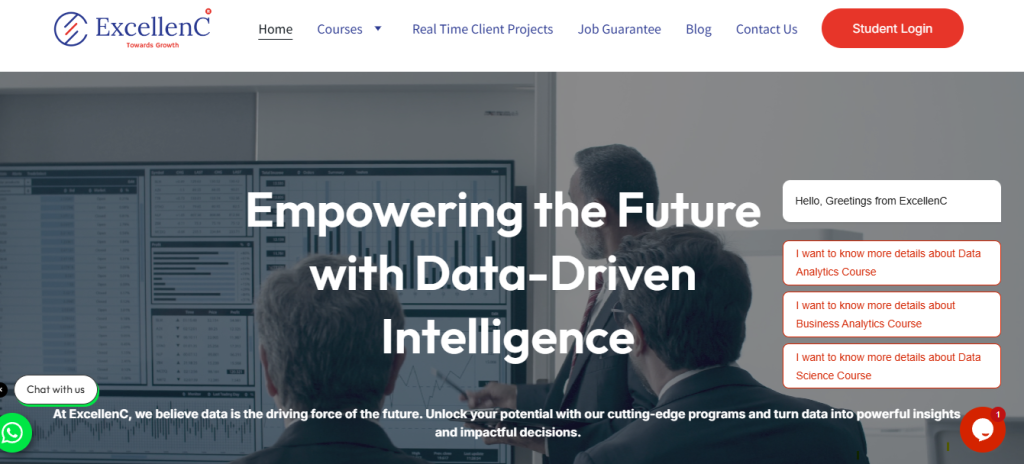
ExcellenC is the edtech arm of Analytics Space, a project-based organization committed to bridging the gap between education and industry. At ExcellenC, they offer Diploma Programs in Data Analytics, Business Analytics, and Data Science, each thoughtfully integrated with Generative AI—the future of intelligent technology.
Their programs are delivered in collaboration with Texas Tech University, ensuring global academic standards. Additionally, the course content is officially certified by TCS iON, affirming its alignment with current industry requirements.
ExcellenC goes beyond traditional training—they focus on building lifelong careers. That’s why they offer a 100% Job Guarantee, backed by a conditional offer letter provided at the time of enrollment.
As part of their hands-on learning model, students work on real-time client projects from Analytics Space, gaining valuable industry experience while they learn. To further support students in their career journey, ExcellenC also provides an internship experience letter for the entire duration of the course.
ExcellenC truly stands out as a place where education meets real-world impact.
Location: Madhapur, Hyderabad
Courses Offered
- Diploma in Data Analytics with Generative AI
- Diploma in Business Analytics with Generative AI
- Diploma in Data Science with Generative AI
Contact Details
WhiteScholars
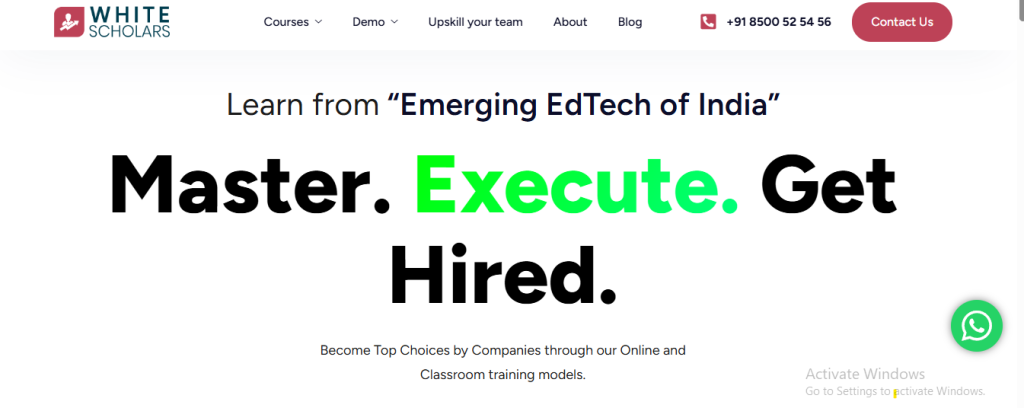
WhiteScholars Academy, established in 2021 and based in Kukatpally, Hyderabad, is a top choice for learning data analytics, data science, and digital marketing. They offer both online and classroom training with a focus on real-time projects, beginner-friendly teaching, and placement support.
Students benefit from resume building, mock interviews, and virtual internships with top companies like Microsoft, Meta, and PwC. With expert trainers and small batch sizes, WhiteScholars is ideal for freshers and professionals looking to upgrade their careers.
Location: Kukatpally, Hyderabad
Courses Offered
- Data Science
- Digital Marketing
- Data Analytics
Contact Details














